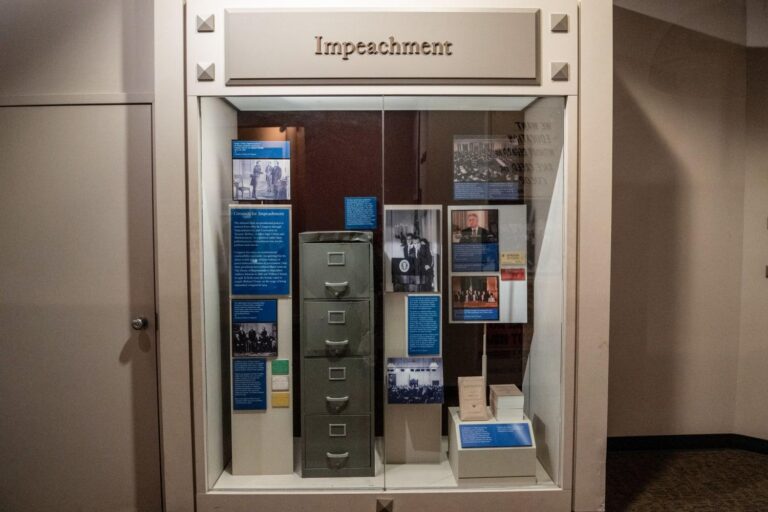Rethinking Impeachment Exhibits at the SmithsonianŌĆÖs National Museum of American History
The Smithsonian Institution has recently revised its impeachment exhibit at the National Museum of American History, removing explicit mentions and images of former President Donald Trump. This change comes amid ongoing discussions about how museums should portray recent and politically charged events. Instead of focusing on individual figures, the updated exhibit now adopts a broader lens, exploring impeachment as a constitutional mechanism and its historical significance across different presidencies.
The revamped display emphasizes a thematic overview of impeachment, covering:
- The constitutional origins and legal framework of impeachment
- Historical cases involving U.S. presidents subjected to impeachment proceedings
- The broader political and societal repercussions of impeachment trials
| Presidential Impeachment | Year(s) | Senate Verdict |
|---|---|---|
| Andrew Johnson | 1868 | Not Convicted |
| Bill Clinton | 1998 | Not Convicted |
| Donald Trump | 2019 & 2021 | Not Convicted on Both Occasions |
Impact on Historical Interpretation and Public Trust
The SmithsonianŌĆÖs removal of direct references to Donald TrumpŌĆÖs impeachments signals a notable shift in how presidential accountability is framed within public history. This editorial choice reshapes the narrative by omitting a highly unprecedented and divisive chapter in American politics, prompting debate about the responsibilities of national museums in preserving an unbiased historical record.
Such curatorial decisions influence public understanding in several ways:
- Transparency Concerns: Omitting significant events risks presenting a diluted version of history, potentially obscuring the complexities of political oversight and governance.
- Polarization Effects: The removal may be perceived as either political censorship or a corrective measure, deepening partisan divides among museum visitors and the wider public.
- Future Precedents: This approach could encourage similar edits in future exhibits, where political considerations override comprehensive historical documentation.
| Dimension | Possible Consequence |
|---|---|
| Institutional Credibility | Critics may question impartiality and accuse the museum of political bias |
| Educational Depth | Students and visitors might receive an incomplete understanding of impeachmentŌĆÖs role |
| Historical Integrity | Risk of creating a fragmented or skewed historical record |
Guidelines for Transparent and Inclusive Museum Curation
Experts in museum studies and history advocate for openness in curatorial decisions to maintain public confidence and ensure historical fidelity. They recommend that museums clearly communicate the rationale behind exhibit content choices, especially when dealing with contentious figures or events. This transparency fosters informed dialogue and helps contextualize sensitive topics without diminishing their significance.
In addition, inclusion specialists highlight the importance of embracing diverse perspectives to reflect the multifaceted nature of American society. Effective strategies include:
- Collaborating with community groups and stakeholders during exhibit development
- Incorporating narratives from marginalized or underrepresented populations alongside mainstream accounts
- Utilizing interactive and multimedia tools to engage a wider audience
These approaches enrich the educational experience and challenge conventional historical narratives, transforming museums into vibrant spaces for critical reflection and learning.
Navigating Political Sensitivity While Upholding Educational Values
The SmithsonianŌĆÖs recent exhibit revision underscores the delicate balance museums must strike between addressing politically sensitive subjects and preserving educational integrity. Curators face the challenge of presenting factual, comprehensive histories while acknowledging the diverse viewpoints of their audiences. Maintaining this equilibrium demands careful editorial judgment, especially when the topics remain highly divisive.
Scholars and museum professionals suggest adopting transparent frameworks that prioritize accuracy, context, and inclusivity. By presenting multiple perspectives and equipping visitors with analytical tools, museums can foster nuanced understanding and reduce perceptions of bias or censorship. The table below outlines key considerations for curators managing politically charged content:
| Consideration | Recommended Approach | Expected Benefit |
|---|---|---|
| Accuracy | Use verified sources and primary documents | Strengthens trustworthiness and educational impact |
| Contextual Depth | Provide historical background and diverse viewpoints | Encourages critical thinking and balanced perspectives |
| Community Engagement | Involve advisory groups and public feedback | Reduces controversy and enhances inclusivity |
| Transparency | Disclose curatorial choices and reasoning | Builds accountability and public confidence |
- Educators stress the importance of preserving historical truth despite political pressures.
- Visitors desire exhibits that challenge their views while respecting differing opinions.
- Museum leaders aim to uphold institutional integrity while fostering open dialogue.
Conclusion: Reflecting on the Role of Museums in Political History
The SmithsonianŌĆÖs choice to exclude direct references to Donald TrumpŌĆÖs impeachments from its exhibit highlights the ongoing complexities museums face when interpreting recent political events. As institutions tasked with preserving and presenting history, museums must navigate evolving narratives and public sensitivities carefully. This development is likely to spark further conversations about how national museums can responsibly document contentious episodes while promoting informed public engagement with AmericaŌĆÖs political heritage.







